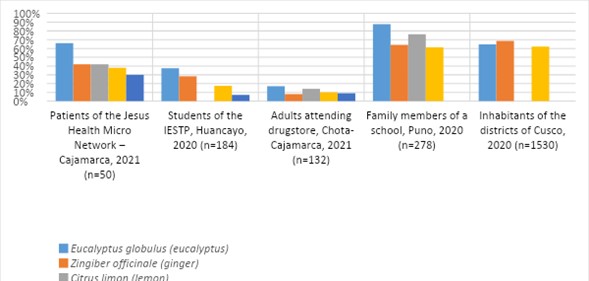Mr. Editor:
Peru is one of the countries with the highest numbers of deaths from COVID-19 per million inhabitants in the world and ranks as the third country with most total deaths in Latin America and the Caribbean1. Despite the advances to combat COVID-19, the future of the pandemic is uncertain based on new variants of the virus that could lead to a new collapse of health services. This has led many Peruvians to consider herbal medicine as a potentially effective therapeutic alternative, thus becoming a very generalized and even informal practice.
Despite the existence of a great number of Peruvian vegetable species for medicinal purposes, and more than 200 articles that showcase their antiviral activities, there is little evidence of their use in the Peruvian population to fight COVID-19. This situation could be problematic considering that many of these plants have not been studied in clinical trials, and their safety profiles are not fully understood. Therefore, elucidating the ethnopharmacological profile of the Peruvian population to combat this virus is essential, not only to foster the development of new phytomedicine, but also to validate its traditional use in the population.
In this sense, five studies carried out in Peruvian populations were analyzed in the present work to identify the medicinal plants most used in the prevention and treatment of COVID-19. As a result, it was found that the top five most used plants were Eucalyptus globulus, Zingiber officinale, Citrus limon, Allium sativum, and Allium cepa (Figure 1). In order to elucidate the level of evidence available for each of them with respect to COVID-19, a review of their potentialities was performed, documented to date mostly in coupling and molecular screening studies (in silico), and laboratory studies carried out outside a living organism (in vitro).

Figure 1 Most used medicinal plants by five Peruvian populations to combat COVID-19 (11,12,13,14,15) .
Eucalyptus globulus has a potentially effective characteristic to combat the cytokine storm and prevent a fatal outcome from COVID-19. In molecular coupling studies, eucalyptol showed activity against the main protein of SARS-CoV-2, as well as the ability to couple to the active site of 3CLpro / Mpro, which would hinder the viral replication2. In silico, the apigenin-o-7-glucuronide bioactive had a greater inhibitory potential for protease and polymerase compared to lopinavir and remdesivir 3. Therefore, we recommend carrying out in vitro studies of this plant for COVID-19.
Zingiber officinale has anti-inflammatory and antiviral properties. Specifically, its extracts, rich in gingerols and shogaols, are capable of attenuating the effects of the cytokine storm by reducing IL-64, a mechanism similar to that of tocilizumab. Molecular screening studies reveal nine phytoconstituents with potential antiviral activity, especially ketophenol and 6-gingerol, since they inhibit SARS-CoV-2 proteins and bind to the ACE2, 3CLpro and PLpro receptors with high affinity, even better than lopinavir, ritonavir, and hydroxychloroquine5. However, there are no in vitro studies that can validate these properties.
In like manner, flavonoids are phytonutrients that constitute Citrus limon, along with naringenin. In molecular coupling analysis studies, some flavonoid metabolites bound and inactivated the active site of SARS-CoV-2 proteins, whilst naringenin inhibited the main SARS-CoV-2 protease: 3CLpro; and reduced the activity of the ACE2 receptors6. Its ability to attenuate inflammatory responses is another of its properties, which could offer therapeutic effects against COVID-19. However, in an in vitro study, the extract from its shell showed a low inhibitory capacity against SARS-CoV-27.
Allium sativum L. has sulfur phytochemicals that provide it with anti-inflammatory properties, with the potential to reverse the clinical picture of patients with COVID-19. In addition to the significant benefits of its immunostimulatory capacity, its diallyl sulfide component could indirectly control the cytokine storm induced by COVID-19. By means of molecular coupling, 17 compounds of its essential oil interacted to inhibit the ACE2 receptor and the main protease of SARS-CoV-28; allicin and alliin inhibited the protease activity and the Mpro of SARS-CoV-2, respectively9.
Out of the 22 Allium cepa phytochemicals examined in molecular screening studies, 12 showed good binding affinities to the main SARS-CoV-2 protease and the ACE2 receptor10. One of these phytochemicals, oleanolic acid, also reported anti-COVID-19 activity in silico, exhibiting a higher coupling score than remdesivir, lopinavir, and nelfinavir10. In the same type of study, it was found that its triterpenoid and flavonoid compounds exhibited a promising binding affinity to the SARS-CoV-2 type 3C protease and to the human ACE2 receptor10. However, an in vitro study showed that the extract from its shell had a low inhibitory capacity against SARS-CoV-27.
Most of the plants currently used by the Peruvian population have not even been evaluated in vitro. Therefore, these types of studies and clinical trials are still required in order to have solid evidence of their effectiveness and to isolate compounds with potential pharmacological use. Their phytochemical and toxicological study would make it possible to provide valid recommendations regarding their effectiveness and reduce any risk associated with their misuse. Moreover, we also suggest further investigation of the use of the allicin of Allium cepa in nebulized form, as well as the rhizome of Zingiber officinale to alleviate fever and other symptoms of COVID-19.















